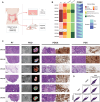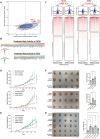Chromatin Remodeling in Patient-Derived Colorectal Cancer Models
- PMID: 38380561
- PMCID: PMC11040356
- DOI: 10.1002/advs.202303379
Chromatin Remodeling in Patient-Derived Colorectal Cancer Models
Abstract
Patient-Derived Organoids (PDO) and Xenografts (PDX) are the current gold standards for patient-derived models of cancer (PDMC). Nevertheless, how patient tumor cells evolve in these models and the impact on drug response remains unclear. Herein, the transcriptomic and chromatin accessibility landscapes of matched colorectal cancer (CRC) PDO, PDX, PDO-derived PDX (PDOX), and original patient tumors (PT) are compared. Two major remodeling axes are discovered. The first axis delineates PDMC from PT, and the second axis distinguishes PDX and PDO. PDOX are more similar to PDX than PDO, indicating the growth environment is a driving force for chromatin adaptation. Transcription factors (TF) that differentially bind to open chromatins between matched PDO and PDOX are identified. Among them, KLF14 and EGR2 footprints are enriched in PDOX relative to matched PDO, and silencing of KLF14 or EGR2 promoted tumor growth. Furthermore, EPHA4, a shared downstream target gene of KLF14 and EGR2, altered tumor sensitivity to MEK inhibitor treatment. Altogether, patient-derived CRC cells undergo both common and distinct chromatin remodeling in PDO and PDX/PDOX, driven largely by their respective microenvironments, which results in differences in growth and drug sensitivity and needs to be taken into consideration when interpreting their ability to predict clinical outcome.
Keywords: ATAC‐seq, Colorectal Cancer (CRC); Patient‐Derived Models of Cancer (PDMC); Patient‐Derived Organoids (PDO); Patient‐Derived Xenografts (PDX).
© 2024 The Authors. Advanced Science published by Wiley‐VCH GmbH.
Conflict of interest statement
H.C.’s full disclosure is given at
Figures




References
-
- van de Wetering M., Francies H. E., Francis J. M., Bounova G., Iorio F., Pronk A., van Houdt W., van Gorp J., Taylor‐Weiner A., Kester L., McLaren‐Douglas A., Blokker J., Jaksani S., Bartfeld S., Volckman R., van Sluis P., Li V. S. W., Seepo S., Sekhar Pedamallu C., Cibulskis K., Carter S. L., McKenna A., Lawrence M. S., Lichtenstein L., Stewart C., Koster J., Versteeg R., van Oudenaarden A., Saez‐Rodriguez J., Vries R. G. J., et al., Cell 2015, 161, 933. - PMC - PubMed
-
- Fichtner I., Slisow W., Gill J., Becker M., Elbe B., Hillebrand T., Bibby M., Eur. J. Cancer 2004, 40, 298. - PubMed
-
- Drost J., Clevers H., Nat. Rev. Cancer 2018, 18, 407. - PubMed
Publication types
MeSH terms
Grants and funding
LinkOut - more resources
Full Text Sources
Medical
Research Materials
Miscellaneous
